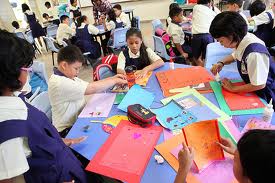This article provides a set of tips for raising your awareness of learning styles as a major factor in how children learn. These tips are adapted from the resources listed at the end of this article.
The tips are based on the Dunn & Dunn Learning Styles Model developed by Professors Rita and Kenneth Dunn to assist the New York State Department of Education in improving the effectiveness of instruction for students not demonstrating sufficient progress. The model is based on 20 elements, divided among five categories (called stimuli in the model), that affect learning. Use of the model has been statistically proven to improve student performance.
The model's five stimuli are environmental, emotional, sociological, physiological, and psychological. A nice illustration of the stimuli and elements is here. A very similar model, the Learning Styles Pyramid Model is illustrated here.
The first half of the tips are not specific to Math and apply to a broad range of learning situations. The second half are Math-specific.
- Ask your child how he learns best
- Notice whether your child learns better in the morning, afternoon, or evening
- Introduce a lesson by relating its content to your child's life
- Use anecdotes and stories to convey the practical relevance of lessons
- Use humor, songs, poetry, cartoons, drama and color to capture attention and stimulate receptivity and learning
- Use pictures, drawings, graphs, illustrations, and charts to engage the visual sense
- Allow flexibility in lighting (natural, bright, soft, dim, incandescent vs. fluorescent)
- Allow flexibility in seating arrangement (experiment with casual and relaxed seating)
- Encourage use of white boards, bulletin boards, outside areas, and large floor space for your child to demonstrate what he is learning
- Notice whether the room is too cold or too warm for your child
- Try incorporating soft background music into the learning environment (with no lyrics to distract)
- Notice whether your child prefers to work alone, in a group, or with adult or authority figures
- When working in groups, encourage a 60 second break every 15 minutes to review with others, what the children just learned
- Explore with your child if he learns best while snacking
- For learning about numbers and operations try counters, Cuisenaire rods, blocks, chips, abaci, wooden cubes, and counting sticks
- For more advanced learners, try number lines, charts, computers, and calculators
- Use card and board games and let your child create his own games
- Encourage your child to create his own word problems to provide a context for what he 's learning as well as to support his computation
- In early algebra lessons, start with tables and graphs to show relevance of the material
- Use geometric models, geoboards, rectangular dot paper, geoblocks, tiles, tangrams, and mirrors to sketch and record shapes
- Have kids learn about points, lines, angles and other geometric ideas by using their hands and arms to illustrate the ideas. This can be especially fun if there is a group of kids to illustrate these ideas together.
- Support learning of measurement through instruments: rulers, meter sticks, tape measures, trundle wheels, graduated beakers, measuring cups and spoons, kitchen and bathroom scales, thermometers, timers, clocks, and protractors
- Try having your child work out a problem on a white board and see if having him stand makes a difference
- Encourage your child to talk about what he learned, give feedback, and show him how to apply what he has learned to his life
- Use story books to teach Math concepts such as time, money, measurement, and problem-solving
- Teach about data analysis, probability, and statistics through newspaper graphics, newspapers, and charts. Also, use dice, coins, cards, colored cubes, chips, spinners, graph paper, squares, calculators, and computers.





















I agree with your opinion, is clearly related to the number of mathematics...